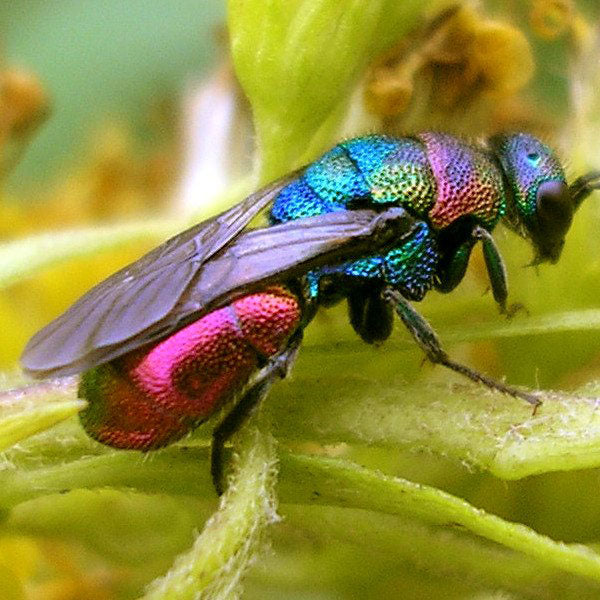Next time you are in the garden, and you see something that resembles a tiny, flying rainbow whiz by, rest assured you are not hallucinating! The mirror-like, prismatic color of Chrysidine wasps it only easy to miss because they are so small, so let’s get a closer look!
OK ok, now, if you are wearing your expensive L.L. Bean socks then I advise not to look at these next pictures, because these Chrysidine close-ups are gonna blow em right off!
Stunning? Yes. But behind that shimmery sheen, these wasps have a dirty little secret: they are cleptomaniacs! Well, cleptoparasites to be exact, a term that describes any animal that steals food from another, whether they are members of the same species or not. Female Chrysidines lay their eggs in the nests of other species, such as wasps and bees, thus saving themselves the time and energy of procuring provisions for their young. This strategy has earned them the common name “cuckoo wasp”, after the birds which pull the same trick.
But Chrysidines take it one step further. Not only do they pawn off their parental duties, once their larvae hatch they proceed to gobble up the host’s larvae and food provisions, not necessarily in that order!
Another common name for Chrysidines is “jewel wasp”, and it’s easy to see why. But it does make you wonder why a species that relies on sneaking undetected into the burrows of ground-nesting bees and wasps would be decked out in such bold colors. But, it is dark down in those nests, so once they are inside the colors probably aren’t too noticeable.
But Chrysidines do get caught sneaking around a lot, and their tough, highly structured, and multi-layered exoskeleton provides protection them from the bites and stings of angry hosts. In fact, it has been suggested that those metallic blues, oranges, pinks, and reds have no specific purpose, and are instead a by-product of light refracting through the open spaces in the many layers of cuticle that make up the Chrysidine exoskeleton. “Oooops, I’m accidentally fabulous!”
Chrysidines can’t sting, so passive forms of defense are all they’ve got. Their ability to tuck their head and legs into a tight little ball when they are found out, much like armadillos, hedgehogs, and pillbugs, is a strategy that is as practical as it is unwittingly adorable. The cupped shape of the inside of their abdomen allows them to do this.
 There are so many situations in life where I wish I had evolved the ability to curl up into a perfect little ball.
There are so many situations in life where I wish I had evolved the ability to curl up into a perfect little ball.
It’s amazing to think of all the tiny insect dramas that are playing out in the garden and beneath our feet. And with roughly 3,000 species of Chrysidines found all over the world, you can find them practically anywhere, but they are especially abundant in desert regions as well as the warm Mediterranean climate of California. In fact I found this little guy in death throes on my windowsil!
So next time you see one of these colorful little ninjas in your garden, just remember there is more to them than meets the eye!
Special thanks to Iziko Museums of South Africa at waspweb.org as well as Laurie Knight for letting me use their stunning images!
More of Knight’s amazing photos can be found here: http://www.flickr.com/photos/laurie-knight/
(Repost): Original Post: https://thebefuddledloris.wordpress.com/2014/01/03/pretty-pretty-parasite/






